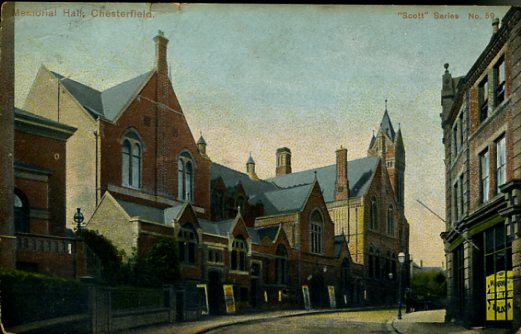Chesterfield’s museum and Pomegranate theatre are set for a major revamp following the award of a substantial grant to upgrade the facility. In this blog we briefly review the history of the building – still known as the Stephenson Memorial Hall.
As part of the Chesterfield and District Civic Society’s submission to the planning application to update the facility our county editor (who is also chairman of the society) has written a short review of the building’s history. Below is an edited version.
Opening

The Memorial Hall, opened in 1879, was built by the Chesterfield & Derbyshire Institute of Mining, Civil and Mechanical Engineers, founded eight years earlier, as their headquarters, although it was intended also to be used as a centre for technical education. The Chesterfield and Brampton Mechanics’ Institute also contributed.
Chesterfield Corporation made a contribution to the cost on condition that they could open a public library and reading room in the building. The Hall also became a centre for Cambridge University Extension Classes, which marks the beginning of non-vocational adult education in Chesterfield.
Rudimentary dressing rooms were provided for performers using the platform in the main lecture hall, but theatrical or musical entertainments were a very minor part of the plan. There was no bar or refreshment room in the original scheme.
The Stephenson connection
The building was named in memory of George Stephenson (1781–1848). For the last ten years of his life Stephenson leased Tapton House, just outside the town, and chose to be buried at Holy Trinity church on Newbold Road, rather than in his native North East. (Incidentally, Stephenson’s connection with Chesterfield, then as now, tends to be exaggerated somewhat).
George’s son Robert did not really maintain the connection with Chesterfield, nor with the coal and iron company his father founded at Clay Cross. Several of the leading members of the Chesterfield & Derbyshire Institute were also members of the Institution of Mechanical Engineers, founded by Stephenson in 1847, and obviously saw him as their hero, which is presumably why the Hall was dedicated to his memory.
Changes
The Hall was far too ambitious a venture for a small provincial engineering institute, especially in the slump which affected their industry in the 1880s. In 1889 the institute sold the building to Chesterfield Corporation for a sum equal to the debt left over from its construction.
In the 1890s the corporation acquired the garden of Kilblean House, which adjoins the Hall to the east, and used the land to build a stage, with a fly-tower and dressing rooms, to replace the platform in the main lecture hall. It was probably at this date that raked seating was introduced on the ground floor and an attempt made to remodel the gallery as a ‘circle’. These changes were not entirely successful and to this day the Pomegranate retains the character of a converted lecture hall, not a purpose-built theatre. The caretaker’s house on Station Back Lane also dates from this period.
A further change took place after 1901, when a new dual-purpose building was erected at the Grammar School on Sheffield Road, to be used during the day by the school and in the evening by technical classes previously accommodated in the Memorial Hall. This enabled the corporation to take over more rooms at the Hall, alongside the library. The main auditorium became the Corporation Theatre in 1904, although until just after the Second World War it functioned mainly as a cinema and was let to a commercial operator.
The council staff moved to the new Town Hall in 1938, allowing the library to expand into the whole of the western end of the building. (The council had offices and a council chamber in the Memorial Hall).
Full circle?
After the war the corporation resumed control of the theatre and reopened it in 1949 as England’s first local authority Civic Theatre, with a resident repertory company. The cost later became unsustainable and, after a period in which it was threatened with closure, the Borough Council refurbished the interior, renamed the theatre the Pomegranate, and from 1982 operated it as a receiving house and later a venue for live screenings. It is occasionally used for other events, notably the very successful annual Derbyshire Archaeology Day. This was originally a Sheffield University extramural day-school and so in that respect the Hall has come full circle to be used once again for adult education.
Finally, in 1984 the county council, which replaced the borough council as the library authority in Chesterfield in 1974, opened a new branch library on New Beetwell Street and the rooms at the Memorial Hall formerly occupied by the library became a museum, opened in 1994, which Chesterfield had previously lacked.
We previously posted about the missing statue of George Stephenson at the Memorial Hall in a previous blog.
The Chesterfield and District Civic Society’s full response to the planning application will be posted on their website. They have, incidentally, strongly objected to the museum’s proposed display reorganisation. This seems to adopt a ‘Character Driven‘ approach, instead of telling the chronological story of Chesterfield’s history by using objects, text and audio-visual displays.
